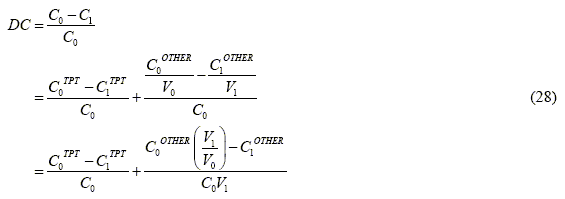Appendix 2. New Derivation of DC for NCHRP342
While reviewing Report 342, a problem was identified with the definition and derivation of DC, as the proportional change in operating costs per vehicle mile of use at current volumes or level of service. The problem, stemming from non-additive proportional changes, has now been resolved and can be found below.
At Appendix D, DC was defined as the proportional change in total operating costs to the firm per physical unit given current transport volume or level of service. A problem was determined with the derivation of DC when substituted into subsequent expressions. The cause of these difficulties was identified as taking a sum of proportional changes. A revised derivation is developed here.
By definition, it is possible to write DC as![]() DC = (C0 − C1)/C0, where
DC = (C0 − C1)/C0, where![]() C0 is the current average user cost per physical unit, and
C0 is the current average user cost per physical unit, and![]() C1 is the user cost per physical unit after highway improvements. The problem arises when DC is expressed in terms of direct and indirect savings. In general, proportionate changes are not additive. A revised expression is developed below based on first principles.
C1 is the user cost per physical unit after highway improvements. The problem arises when DC is expressed in terms of direct and indirect savings. In general, proportionate changes are not additive. A revised expression is developed below based on first principles.
Let![]() C0T be the total annual logistics cost to the firm. This cost is decomposed as:
C0T be the total annual logistics cost to the firm. This cost is decomposed as:
where total cost![]() C0T is the sum of transportation costs, inventory costs (incl. warehousing and holding), and procurement costs. In-transit inventory carrying costs are assumed to be captured by overall procurement costs. For simplicity, the later two costs in (1.1) will be denoted as
C0T is the sum of transportation costs, inventory costs (incl. warehousing and holding), and procurement costs. In-transit inventory carrying costs are assumed to be captured by overall procurement costs. For simplicity, the later two costs in (1.1) will be denoted as![]() C0OTHER.
C0OTHER.
The average cost per vehicle mile is then:

This expression, and that for![]() C1 can be substituted into DC. We obtain:
C1 can be substituted into DC. We obtain:

The new expression states that the proportionate change in average cost per vehicle mile is a combination of proportionate savings in transportation and a scaled change in other costs. With this correction, the expression for DC can then be carried forward in the determination of consumer surplus.
previous